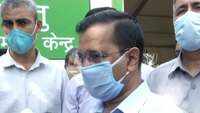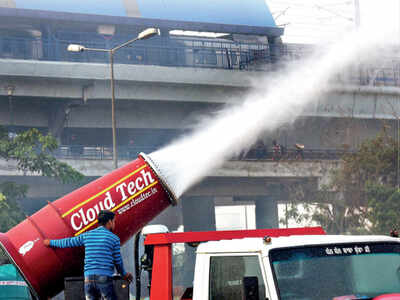
NEW DELHI: Ahead of the pollution season, more than 10 anti-smog guns have been installed at major construction sites located across south Delhi areas. More such guns are likely to be installed in Delhi before October 15, including at some landfill sites where large-scale biomining work is under way, a senior municipal official said.
“South Delhi Municipal Corporation has ordered its executive and assistant engineers to initiate action against big construction sites, which have still not deployed anti-smog guns. A letter of award has been issued for procurement of one smog gun by the corporation. It is likely to be installed by October 15,” the official added.
An anti-smog gun sprays tiny droplets of water into the atmosphere, creating artificial mist. Small droplets of water are expected to stick to air-borne pollutants and bring them down to the ground. Such guns can throw water mist up to a distance of 100m covering a large area, which may be a source of particulate matter.
According to an order issued by the south corporation in February, such anti-smog guns are mandatory at sites that are larger than 20,000 sqm and less than 1.50 lakh sqm. Most of the installed units are located in Dwarka under Najafgarh zone while three project sites in Central zone.
A senior north corporation official confirmed that an anti-smog gun would be installed at the Bhalswa landfill site where 4,200 tonnes of waste were being processed every day. “The unit will be in place by October 15,” the official said. “Besides anti-smog guns, we have a fleet of 134 water tankers, which will be sprinkling water over 1,340 km of road every day,” he added.
Last year, the apex court had directed the use of anti-smog guns in Delhi and NCR for large construction sites, road construction stretches, mining activities, large parking sites on unpaved areas and during large public gatherings and demolition activities. While some experts have raised doubts over the efficacy of the anti-smog guns, the top court had in the past junked the intervention application by a Delhi-based doctor who doubted the efficiency of these towers in the backdrop of limited research data.
“South Delhi Municipal Corporation has ordered its executive and assistant engineers to initiate action against big construction sites, which have still not deployed anti-smog guns. A letter of award has been issued for procurement of one smog gun by the corporation. It is likely to be installed by October 15,” the official added.
An anti-smog gun sprays tiny droplets of water into the atmosphere, creating artificial mist. Small droplets of water are expected to stick to air-borne pollutants and bring them down to the ground. Such guns can throw water mist up to a distance of 100m covering a large area, which may be a source of particulate matter.
According to an order issued by the south corporation in February, such anti-smog guns are mandatory at sites that are larger than 20,000 sqm and less than 1.50 lakh sqm. Most of the installed units are located in Dwarka under Najafgarh zone while three project sites in Central zone.
A senior north corporation official confirmed that an anti-smog gun would be installed at the Bhalswa landfill site where 4,200 tonnes of waste were being processed every day. “The unit will be in place by October 15,” the official said. “Besides anti-smog guns, we have a fleet of 134 water tankers, which will be sprinkling water over 1,340 km of road every day,” he added.
Last year, the apex court had directed the use of anti-smog guns in Delhi and NCR for large construction sites, road construction stretches, mining activities, large parking sites on unpaved areas and during large public gatherings and demolition activities. While some experts have raised doubts over the efficacy of the anti-smog guns, the top court had in the past junked the intervention application by a Delhi-based doctor who doubted the efficiency of these towers in the backdrop of limited research data.

Coronavirus outbreak
Trending Topics
LATEST VIDEOS
City
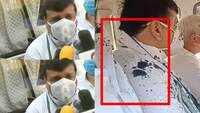 UP: Ink thrown at AAP leader Sanjay Singh after he met Hathras victim's kin
UP: Ink thrown at AAP leader Sanjay Singh after he met Hathras victim's kin 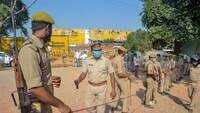 Hathras horror: UP Police file 19 FIRs, allege ploy to push state into turmoil
Hathras horror: UP Police file 19 FIRs, allege ploy to push state into turmoil 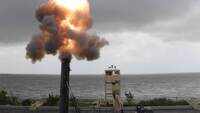 India successfully flight tests weapon system SMART from Wheeler Island off the coast of Odisha
India successfully flight tests weapon system SMART from Wheeler Island off the coast of Odisha  24-year-old Delhi man stabbed to death for resisting snatching bid
24-year-old Delhi man stabbed to death for resisting snatching bid
More from TOI
Navbharat Times
Featured Today in Travel
Get the app

